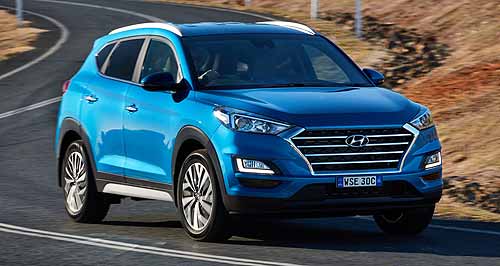Make / Model Search
New models - Hyundai - TucsonHyundai details updated Tucson SUVInitial driveaway deals, lower entry point, added spec for refreshed Hyundai Tucson8 Aug 2018 HYUNDAI Motor Company Australia (HMCA) has announced pricing and specification for its updated Tucson medium SUV range that ushers in a new entry-level variant, tweaked styling, greater active safety and driveaway pricing at launch for its four most affordable variants.
The entry-level Active, which previously kicked off at $28,590 plus on-roads, has been replaced by the new Go that has a driveaway price of $27,990 for the entry-level 2.0-litre petrol manual through August.
Other variants offered with initial driveaway pricing are the petrol automatic Go ($29,990), and the equivalent Active X versions, at $30,990 for the manual and $32,990 for the auto.
Recommended retail pricing for the entry-level Go starts at $28,150 for the 2WD petrol manual, down $440 on the superseded Active. Still topping the range is the turbo-diesel, all-wheel-drive Highlander, which is $1350 dearer at $48,800.
Like the outgoing range, four specification levels will offered – Go, Active X, Elite and Highlander – with three engine choices including the 121kW/203Nm 2.0-litre aspirated petrol engine, the 130kW/265Nm force-fed 1.6-litre petrol donk and the 136kW/400Nm 2.0-litre turbo-diesel unit offered across the range.
No changes have been made to the engine line-up except for the turbo-diesel, which swaps out the existing six-speed automatic transmission for an eight-speed unit that Hyundai says helps to reduce fuel consumption.
The Tucson gets some light visual updates, including a sharper iteration of the signature cascading grille, tweaked headlights and tail-lights, and new wheel designs.
Hyundai says the new range packs more standard specification than the outgoing model, with the entry-level Go offered with a new floating-style 7.0-inch touchscreen with Apple CarPlay and Android Auto compatibility, exterior mirror turn signals, rearview camera, six airbags, automatic headlights, LED daytime running lights, 17-inch steel wheels with a full-size spare, cruise control, power windows, roof rails, tonneau cover and Hyundai Auto Link.
The Go comes with the 2.0-litre petrol unit driving the front wheels via a six-speed manual or auto, or the turbo-diesel with all-wheel drive.
Moving up to the Active X, which shares its powertrains with the Go, adds 17-inch alloy wheels, tyre pressure monitor, rear parking sensors, leather-appointed seats, a larger 8.0-inch satellite navigation system with DAB+ digital radio, eight-speaker audio, two-way electric lumbar support, power folding and heated exterior mirrors and a rear console USB port.
Next up is the Elite, which is offered with the 2.0-litre petrol auto, 1.6-litre turbo petrol or 2.0-litre oil burner, and gains 18-inch alloy wheels, power driver’s seat, smart key and push button start, rain-sensing wipers, privacy glass, alloy garnish on power window switches, chrome exterior door handles, matte grey side garnish insert and a luggage net.
The Elite gains Hyundai’s SmartSense safety pack as standard, which includes blind-spot warning, driver attention alert, forward collision warning, autonomous emergency braking, high-beam assist, lane-keep assist, rear cross-traffic alert, active cruise control with stop & go, dual-zone climate control, electronic parking brake, mirror puddle lamps, glovebox cooling and drive mode select for all-wheel-drive variants.
Go and Active X buyers can option the SmartSense pack on automatic variants for $2200.
Topping the range, the Highlander – which is offered with either the 1.6-litre turbo-petrol or 2.0-litre diesel – adds 19-inch alloys, LED headlights and tail-lights, front parking sensors, wireless phone charging, panoramic glass sunroof, power passenger seat, heated and ventilated front seats, smart power tailgate, 4.2-inch digital instrument cluster display, electrochromatic rearview mirror, heated steering wheel, driver’s knee bolster, solar glass, matte grey front and rear skid plates, twin-tip exhaust and Hyundai Auto Link Premium.
Like other Hyundai models, the Tucson has undergone an Australia-specific suspension and steering tune.
Through the first seven months of the year, Hyundai has sold 11,770 examples of the Tucson, down 19.1 per cent year-on-year but still enough to be the second-best selling model for the brand behind the i30 small car (17,158).
The Tucson sits fourth on the medium SUV sales ladder, behind the Mazda CX-5 (16,080), Toyota RAV4 (13,623) and Nissan X-Trail (12,127) and ahead of the Honda CR-V (10,100), Mitsubishi Outlander (9187) and Kia Sportage (8301).
2018 Hyundai Tucson pricing*
*Excludes on-road costs  Read more29th of March 2018  New York show: Hyundai shows off fresh TucsonRevised Hyundai Tucson borrows i30 style and tech in 2018 revamp12th of April 2017  Hyundai sources more Tucsons from KoreaEngine upgrade for Tucson Active and Elite as Hyundai switches factoriesAll new models Alfa Romeo Alfa Romeo Abarth Abarth Alpine Alpine Alpina Alpina Audi Audi Aston Martin Aston Martin BMW BMW Bentley Bentley Chery Chery Brabham Brabham Chrysler Chrysler Chevrolet Chevrolet Cupra Cupra Citroen Citroen DS DS Dodge Dodge Fiat Fiat Ferrari Ferrari Foton Foton Ford Ford Great Wall Great Wall FPV FPV Haval Haval GWM GWM Honda Honda Holden Holden Hyundai Hyundai HSV HSV Isuzu Isuzu Infiniti Infiniti Jeep Jeep Jaguar Jaguar Lamborghini Lamborghini Kia Kia LDV LDV Land Rover Land Rover Lotus Lotus Lexus Lexus Maserati Maserati Mahindra Mahindra McLaren McLaren Mazda Mazda Mercedes-Benz Mercedes-Benz Mercedes-AMG Mercedes-AMG Mini Mini MG MG Nissan Nissan Mitsubishi Mitsubishi Pagani Pagani Opel Opel Porsche Porsche Peugeot Peugeot Ram Ram Proton Proton Rolls-Royce Rolls-Royce Renault Renault Saab Saab Rover Rover Smart Smart Skoda Skoda Subaru Subaru SsangYong SsangYong Tesla Tesla Suzuki Suzuki Toyota Toyota Volvo VolvoTucson pricing
Motor industry news |
|
||||||||||||||||||||||||











Facebook Twitter Instagram